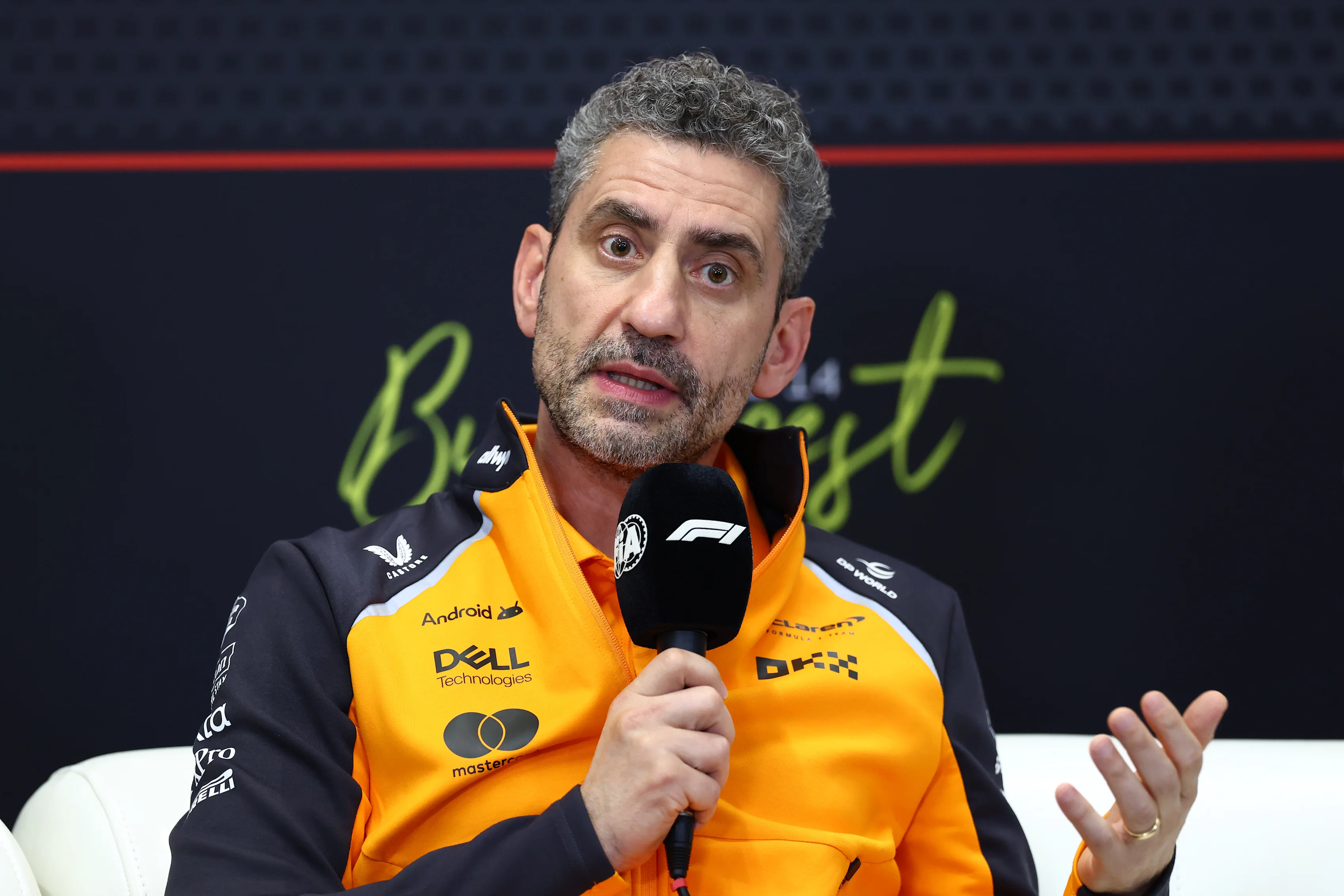The question echoes across the Formula 1 paddock with the force of a starting gun: Can an unfair sanction truly define the future of an entire championship? That is the seismic query unleashed by the events of the Brazilian Grand Prix, where a seemingly straightforward racing incident involving Oscar Piastri, Kimi Antonelli, and Charles Leclerc was transmuted by the FIA into an institutional crisis.
What transpired on the track was not just a collision; it was a perfect storm that exposed a fundamental and growing rift between the raw, high-speed reality of wheel-to-wheel combat and the rigid, binary logic of the sport’s regulatory desk.

The Critical Juncture: Chaos at the Restart
The setting was familiar: a Safety Car restart at Interlagos, one of the calendar’s most iconic and treacherous venues. The pack was tightly grouped, the tires were cold, and the margins for error had effectively vanished. These are the moments every driver understands are critical—a fleeting opportunity to gain an edge or lose precious ground.
It was on the approach to Turn 1 that Oscar Piastri, the Australian talent whose star has risen meteorically with McLaren, saw his opening. He executed a determined, aggressive move, launching himself to the inside to challenge Kimi Antonelli. Simultaneously, Charles Leclerc was looking to position his car on the outermost edge of the corner.
What followed was a moment of triple convergence, three trajectories hurtling toward a single vertex, a scenario defined in milliseconds. Piastri braked deeply, taking a defensive but ultimately valid line at the limit of grip. He briefly locked his front wheels when reaching the braking point—an action that might appear visually alarming, but one that was quickly recovered. Crucially, the car regained grip and its trajectory remained within the limits of the asphalt. According to the spirit of the rules, what matters is controlled recovery, and Piastri achieved it.
The problem arose because Antonelli, positioned in the center, closed his path toward the apex. Leclerc, for his part, maintained his outside line. Physics, as always, prevailed. Piastri was trapped between two converging cars with no room for maneuver, leading to the multiple contact that took Leclerc out of the race, damaged Antonelli’s car, and shattered Piastri’s podium aspirations.
The Binary Logic: The Flawed ‘Mirror Rule’
The stewards’ decision was swift and absolute: Piastri was deemed completely responsible, slapped with a 10-second penalty and two super license points. The justification for this punitive judgment was rooted in the current Driving Standards Guidelines, specifically the principle designed to ensure that the attacking driver has a “right to space.”
The FIA determined that Piastri had not reached the point of “legal coexistence,” citing that his front axle was not at the height of Antonelli’s mirror when reaching the apex. That reason, alone, was considered sufficient to place the entirety of the blame on the McLaren driver. Case closed, at least for the race direction.
However, for many in the paddock—and for anyone who understands the real-time dynamics of F1 racing—this decision represented a catastrophic failure of judgment. It was the blind, rigid application of a rule that completely ignored the context, the pressure, and the real-world dynamics between three cars battling in a notoriously tricky corner. It was an absolute punishment delivered in an absolutely complex situation.

The Fire-Lighter: Leclerc’s Shocking Defense
The criticism began immediately from McLaren, but the true turning point came from the unlikeliest of sources: Charles Leclerc, the driver who was arguably the most victimized by the incident.
In a move that surprised the entire F1 community, Leclerc publicly stated that he did not believe Piastri was the only one to blame. He pointed the finger squarely at the central figure, saying Antonelli closed his path “as if Oscar had never existed,” arguing that responsibility should have been shared.
When the very driver who was eliminated from the race questions the severity and focus of the sanction, something profound is amiss. What seemed like a routine (albeit destructive) racing incident suddenly became the lit fuse of a much larger bomb—a declaration of principles against how the FIA interprets on-track actions from the distant, antiseptic confines of their desks.
Andrea Stella’s Calculated Declaration of War
The response from Andrea Stella, McLaren’s Team Principal, was not a simple media reaction; it was a covert, calculated declaration of war. There was no frothing anger or uncontrolled tantrum from the Italian engineer, but something far more powerful: a calm, methodical, and surgical indictment of the FIA’s sanctioned system.
Stella, in his typical composed tone, began by accepting the existence of the rules but immediately proceeded to dismantle the reasoning behind Piastri’s sanction, piece by piece. He conceded the brief wheel lock, but stressed that Piastri never lost actual control, maintained his line, and had not “launched recklessly” as the regulations define an illegal maneuver.
He then introduced his main missile: while Piastri’s maneuver was controlled and measurable, Antonelli’s reaction—closing the trajectory towards the apex with two cars clearly present on either side—was, at the very least, equally questionable. In McLaren’s view, the responsibility should have been shared or, failing that, mitigated.
Stella then cut to the core systemic flaw: the stewards completely ignored the real dynamics between three cars in the middle of a high-speed corner. He argued that the “mirror rule,” a guide explicitly designed for two-car scenarios, is not fit for purpose in the real chaos of a Safety Car restart with cold tires and accumulated pressure.
The underlying message was a stark and serious warning: the problem is not merely a single sanction, but the entire system. If the rules do not allow a legitimate maneuver by a talented pilot like Piastri to be evaluated with contextual criteria, then those rules are failing their function of fair refereeing, affecting not just McLaren, but the competitive spirit of the entire sport.
Stella’s closing statement was the most powerful of all, leaving the paddock frozen: McLaren cannot remain silent when decisions seem “misaligned with the competitive spirit of the sport.” It was a chilling prophecy, effectively stating, “Today it was Piastri; tomorrow it could be anyone.” For Stella, what is at stake is the competitive integrity of the entire championship, and McLaren is unwilling to look the other way.

The Cage of Driving Standards
Behind the controversy in Brazil lies the very tool the FIA developed to deliver justice: the so-called “driving standards guidelines.” Introduced and reformulated recently, these rules were a response to past officiating scandals, promising to eliminate ambiguity and guarantee uniform judgments.
In theory, they were the ideal solution to clean up the FIA’s reputation. In practice, however, these guidelines are becoming a steel cage, stifling human judgment instead of providing clarity. They are built on a mathematical logic applied to a sport that is inherently inexact.
In the Brazil case, this logic is ruthlessly summarized: the front axle must be at least at the height of the rival car’s mirror before the apex for the attacking car to have a right to space. This is a precise rule, yet deeply problematic because it reduces a three-dimensional context—with multiple actors, changing lines, variable speeds, and cold tires—to a single visual, static reference.
The rule is unanswerable when confronted with the true complexity of racing: What happens when three cars enter the same curve? What happens if one blocks momentarily but can still hold the line? What if the outside car makes a sudden movement to close the gap, as Antonelli appeared to do? The guidelines only require a static positional reference, ignoring the chain of causality and the necessary analysis of responsibility among all participants.
The Piastri case has ignited the fuse, launching an uncomfortable conversation about how the sport is being governed—whether the rules are truly protecting competition or simply shielding the FIA from future criticism. The most worrying implication is that if these voices of dissent are not heard and acted upon, F1 risks becoming a more controlled, more rigid, and ultimately much less exciting spectacle.
The Psychological Cost for a Title Contender
To truly understand the weight of the Brazil incident, one must contextualize it within McLaren’s recent history. The Woking team has undergone a meteoric rise, transforming itself from an intermittent contender into an absolute reference in the championship. This resurgence has been led with a surgical hand by Andrea Stella and anchored by the clinical talent of Oscar Piastri.
Piastri’s driving style—which combines a controlled aggression with an outstanding reading of the environment—has earned him the tactical freedom granted only to drivers fighting for championships.
That is why the Brazil penalty hurts more deeply: it wasn’t just a lost set of points; it was a blow to the confidence and the narrative of a driver building his reputation as a serious title contender. For a team with two drivers operating at the highest level, any external interference perceived as unfair threatens the delicate psychological balance they have worked months to establish. An unjust sanction can generate strategic doubts and internal friction.
McLaren has drawn a line in the sand. This is no longer about the incident in Brazil; it is a battle for the soul of competitive integrity in Formula 1. The message from Stella is clear: the F1 paddock cannot afford to let the spirit of racing be sacrificed on the altar of rigid, mathematical regulation.





